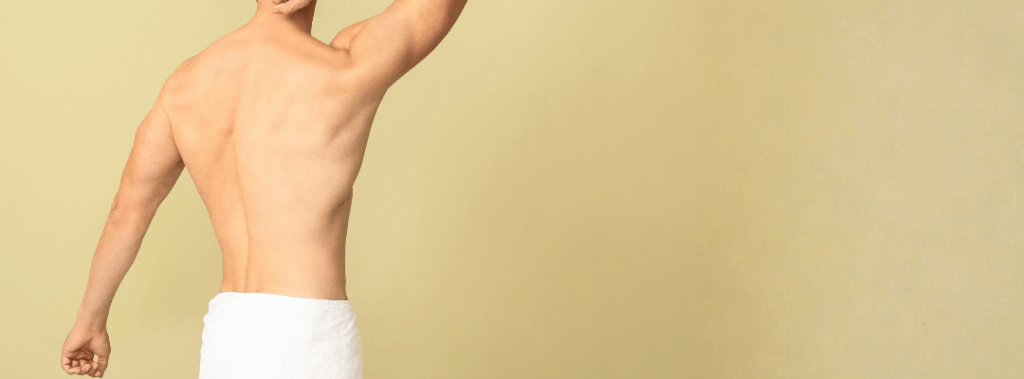The practice of “tucking” is common among many trans women and non-binary people as part of their gender affirmation. For many, it is a valuable tool to feel more comfortable with their physical appearance. However, it is not free of risks or side effects that can affect scrotal, inguinal, or urinary health. In this article, we explain what tucking is, how it is performed, and two of the most common complications: inguinal hernias and varicoceles. We also present possible solutions.
What Is Tucking?
Tucking is a practice that consists of repositioning the testicles into the inguinal canal and placing the penis between the legs or toward the perineal area, with the goal of reducing genital protrusion and achieving a flatter appearance under clothing.
Many trans women use it as part of their gender expression. Gaffs, tucking underwear, or medical tape are often used to maintain the position. Although it can be helpful emotionally and socially, it is not risk-free if performed for long periods or with inappropriate materials.
Partial Tucking or Full Tucking
Tucking can be partial or full. Partial tucking only pushes the penis backward. Full tucking involves repositioning both the testicles and the penis so that no bulge is visible in the pelvic area when dressed.
How safe is tucking?
If you are wondering how safe tucking is, you should know tucking can cause some health problems. The inguinal canal is an anatomically delicate area through which vessels, nerves, and the spermatic cord pass. When the testicles are pushed into this region and constant pressure is applied through tight clothing, the following may occur:
- Skin irritation or inflammation
- Testicular or inguinal pain
- Impaired venous and lymphatic circulation
- Increased risk of inguinal hernia or varicocele, especially in those with anatomical predisposition
- Urinary discomfort or infections due to prolonged compression
Occasional tucking performed with caution is usually safe, but continuous use or excessive compression increases the likelihood of complications.
Inguinal Hernias Due to Tucking: One of the Most Frequent Complications
An inguinal hernia occurs when part of the abdominal contents (usually fat or intestine) protrudes through a weak spot in the groin wall. Tucking can contribute to its development or worsen an existing hernia, especially when the testicles are forcefully pushed into the inguinal canal or when very tight garments—such as bandages or tucking underwear—are worn for hours.
Warning Symptoms of hernia
- Appearance of a lump or bulge in the groin or above the pubic area
- Pain or a feeling of pressure when tucking or walking
- Discomfort that worsens when coughing, lifting weight, or standing
- Testicular pain or a sensation of tightness in the area
If any of these symptoms appear, it is important to see a specialist to rule out a hernia. If untreated, the hernia may enlarge or, in rare cases, become complicated by intestinal entrapment.
How is hernia treated?
Surgical repair is the definitive treatment for an inguinal hernia. It can be performed via open surgery or laparoscopy, with a fast recovery.
For trans women undergoing vaginoplasty, the hernia can be corrected during the same surgical procedure or beforehand to avoid complications during genital reconstruction. If the patient does not wish to undergo vaginoplasty, hernia surgery can be done independently, with excellent functional and aesthetic outcomes.
Varicocele: Dilation of the testicular veins due to tucking
A varicocele is the abnormal dilation of the veins that drain the testicles (pampiniform plexus). It is similar to “varicose veins” in the legs but located in the scrotum. It more commonly affects the left side and may cause pain or a feeling of heaviness.
When the testicles are repositioned into the inguinal canal, venous flow can be impaired. Continuous pressure on the spermatic cord or forced positioning may worsen preexisting venous insufficiency, contributing to the development of a varicocele or increasing discomfort if one already exists.
Common symptoms
- Pain or a sensation of warmth in the testicle, especially at the end of the day
- Swelling or a palpable irregularity
- Discomfort when maintaining a tuck for long periods
- In chronic cases, impaired testicular function or persistent discomfort
Treatment of varicocele
Varicocele treatment may involve surgery (varicocelectomy) or minimally invasive procedures (embolization). For trans women, the approach is planned individually:
- It can be done before vaginoplasty to reduce pain and congestion
- Or during gender-affirming surgery, using the same surgical access
In all cases, combined evaluation by the gender-affirming surgeon and urologist is key to ensuring safety and anatomical preservation.
When should these tucking-related complications be treated?
During vaginoplasty
When the patient is planning a vaginoplasty in the near future, it is usually recommended to evaluate the inguinal region and correct hernias or varicoceles in the same procedure. This allows:
- Reduced future risks
- Avoiding a second anesthesia
- Optimizing functional and aesthetic outcomes
Independently
If the patient does not plan to undergo vaginoplasty or prefers to postpone it, hernia or varicocele surgery can be performed separately without interfering with future genital-affirming procedures.
At IM GENDER, the medical team evaluates each case individually to plan the best surgical sequence and ensure a safe recovery.
Recommendations for safer tucking
Here are some tips to tuck more safely:
- Use soft compression garments without seams or very rigid tapes
- Avoid keeping the tuck for many hours in a row
- Do not sleep with compression garments
- If you feel pain or notice a lump in the groin, consult a specialist
- Take regular breaks and care for the skin in the area
- If you have been diagnosed with a hernia or varicocele, avoid tucking until medically evaluated
Tucking is a useful practice for many trans women, but it requires caution. Inguinal hernias and varicoceles are complications that may appear over time and, if untreated, can cause discomfort or interfere with future gender-affirming surgery.
If you practice tucking and have noticed discomfort or are planning your gender-affirming surgery, schedule a first appointment with the IM GENDER team.




